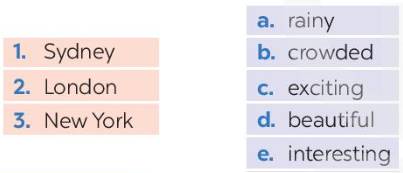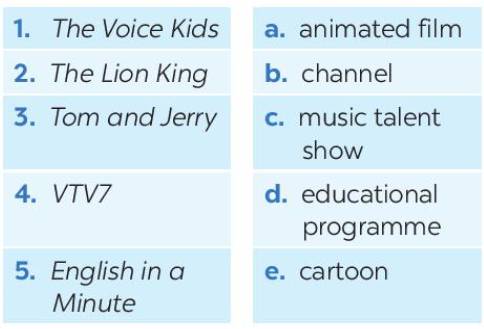Read again. Match.

Listen again. Match the sentences with the speakers (1-3). Some sentences match with more than one speaker.
Which speaker(s)
A. were amazed by the ceremony?
B. had read about the customs before?
C. mention his/her previous trip to Việt Nam?
D. make a positive comment about the bride?
E. understand the meaning of the customs?
Lời giải:
A: 1-2
B: 2
C: 3
D: 3
E: 2-3
Bài nghe:
Speaker 1 During my years as a visiting professor, I was once invited to my student’s wedding in Hoa Binh province. It was fabulous to see the guests in their traditional wedding clothes, and witness the different wedding customs. I don’t know the language, but I could say everyone was welcoming the bride into the new family and wishing the couple all the best. My student said that he had spent 3 years living with his fiancé’s family before getting the girl’s permission to marry her.
Speaker 2 It was so nice to be part of the ceremony. I was fascinated by all the singing throughout the day. All the exchanges between the two families, I mean the greetings, the good wishes, the teachings of the superiors, were inthe form of songs and chants. You could feel their joy and emotions through the music. I managed to make out the meanings of the lyrics thanks to the books and articles about traditional weddings I had read.
Speaker 3 That was the first time I had been to a wedding ceremony in Viet Nam. I was lucky enough to have a chance to see the bride receiving the water from a family member and pouring it into a container. It was so solemn. The bride looked gorgeous! I had watched a documentary about this practice. Well, it reminds the bride of her duties as a caretaker of her own family. Attending a traditional ceremony like that was something I had always wanted to do, but I didn’t manage it on my first trip to Viet Nam.
Tạm dịch:
Diễn giả 1: Trong những năm làm giáo sư thỉnh giảng, có lần tôi được mời dự đám cưới của một học trò ở tỉnh Hòa Bình. Thật tuyệt vời khi nhìn thấy các vị khách trong trang phục cưới truyền thống của họ và chứng kiến những phong tục đám cưới khác nhau. Tôi không biết ngôn ngữ của họ, nhưng tôi có thể biết rằng mọi người đang chào đón cô dâu vào gia đình mới và chúc cặp đôi mọi điều tốt đẹp nhất. Học sinh của tôi nói rằng cậu ấy đã trải qua 3 năm sống với gia đình vợ sắp cưới trước khi được cô gái đồng ý kết hôn.
Diễn giả 2: Thật tuyệt khi được là một phần của buổi lễ. Tôi bị mê hoặc bởi tất cả tiếng hát suốt cả ngày. Mọi sự giao lưu giữa hai gia đình, ý tôi là những lời chào hỏi, những lời chúc tốt đẹp, những lời dạy bảo của các bậc bề trên, đều dưới hình thức là những bài hát và câu hò. Bạn có thể cảm nhận được niềm vui và cảm xúc của họ thông qua âm nhạc. Tôi đã hiểu được ý nghĩa của lời bài hát nhờ những cuốn sách và bài báo về đám cưới truyền thống mà tôi đã đọc.
Diễn giả 3: Đó là lần đầu tiên tôi đến dự một lễ cưới ở Việt Nam. Tôi may mắn được chứng kiến cô dâu nhận nước từ người nhà đổ vào thùng. Nó thật trang trọng. Cô dâu trông thật lộng lẫy! Tôi đã xem một bộ phim tài liệu về hành động này. Ừm, nó nhắc nhở cô dâu về nghĩa vụ của mình với tư cách là người chăm sóc gia đình của mình. Tham dự một buổi lễ truyền thống như thế là điều mà tôi luôn muốn làm, nhưng tôi đã không thực hiện được trong chuyến đi đầu tiên đến Việt Nam.
Read the conversation again and match the cities with the adjectives describing them.

1. Sydney - exciting, beautiful
(Sydney - thú vị, đẹp)
2. London - rainy
(London - nhiều mưa)
3. New York - crowded, interesting
(New York - đông đúc, thú vị)
Read the article again. Match the headings (1-3) with the paragraphs (A-B). There is ONE extra heading.
1. Getting vocational training
2. Earning a salary while studying
3. Going to college or university
1: paragraph B
2: paragraph A
Read the article again. Match the sections (A-C) with the headings (1-5) below. There are TWO extra headings.
1. Eat better
2. Exercise regularly
3. Go to bed earlier
4. Develop healthy habits
5. Sleep well
Read the conversation again and match 1-5 with a-e.

1. The Voice Kids - c. music talent show
(The Voice Kids – chương trình tài năng âm nhạc)
2. The Lion King - a. animated film
(Vua sư tử - phim có nhân vật hoạt hình)
3. Tom and Jerry - e. cartoon
(Tom và Jerry – phim hoạt hình)
4. VTV7 - b. channel
(VTV7 – kênh truyền hình)
5. English in a Minute - d. educational programme
(English in a Minute – chương trình giáo dục)
Read the conversation again and match the two halves in the two columns.

Club leader: Hello. Welcome back. Today we’re discussing environmental problems and environmental protection. What are our serious environmental problems now?
Nam: Pollution and habitat loss, I think.
Ann: I agree. The air and water quality are getting worse and worse.
Club leader: Any others?
Ann: Yes, I can think of some like global warming, endangered species loss, …
Nam: So what should we do to help protect our environment?
Club leader: We can reduce our carbon footprint even in our homes.
Ann: What do you mean by “carbon footprint”?
Club leader: It’s the amount of carbon dioxide we release into the environment.
Ann: I see. So we can do things like turning off devices when we’re not using them.
Club leader: Right … And there is much more we can do, like practising the 3Rs.
Nam: We can plant more trees in our neighbourhood too.
Ann: And try to avoid using single-use products, like plastic bags, and stop littering.
Club leader: Yeah. And we can volunteer at some local environment programmes to save endangered species.
1 - c: reduce our carbon footprint
(giảm thiểu lượng khí thải nhà kính)
2 - d: turn off devices when we're not using them
(tắt các thiết bị khi không sử dụng)
3 - e: plant more trees in our neighbourhood
(trồng thêm cây ở xung quanh nơi bạn sống)
4 - a: avoid using single - use products
(tránh các sản phẩm dùng một lần)
5 - b: stop littering
(ngừng xả rác)
Read the article again. Match the following headings (1-4) with the appropriate paragraphs (A-C). There is ONE extra heading.
1. Organising photo competitions of performing artists
2. Promoting and developing the folk arts
3. Making use of social media to promote heritage
4. Opportunities to learn about heritage and be involved in problem-solving
Paragraph A - 3. Making use of social media to promote heritage
(Đoạn A - Tận dụng mạng xã hội để quảng bá di sản)
Paragraph B - 4. Opportunities to learn about heritage and be involved in problem-solving
(Đoạn B - Cơ hội tìm hiểu về di sản và tham gia giải quyết vấn đề)
Paragraph C - 2. Promoting and developing the folk arts
(Đoạn C - Phát huy và phát triển nghệ thuật dân gian)
Read the article again. Match the highlighted words with their meanings.
1. emissions | a. a gas without smell or colour, often used as a fuel |
2. balance | b. a chemical substance found in all living things |
3. carbon | c. a situation in which different things are equal |
4. methane | d. gases or other substances that are sent into the atmosphere |
Read the news items again and match the highlighted words with their meanings.
1. relations | a. shown over the Internet |
2. eye-opening | b. to act officially for another person or organisation |
3. represent | c. the way in which people or groups of people behave towards each other. |
4. live-streamed | d. surprising because you learn something new |